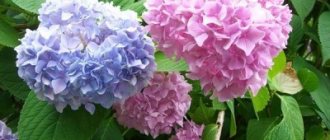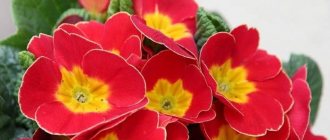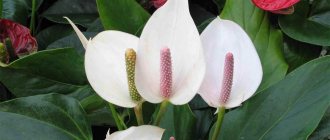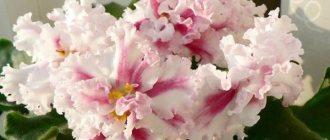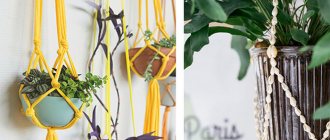Gladiolus is a magnificent flowering plant from the iris family. Translated from Latin, “gladiolus” means “sword”, “sword”, probably the name of this flower was given because of the straight, sharp, erect leaves. Tall slender peduncles with luxurious flowers will take precedence in the parade of flowers in your garden.
Currently, there are a large number of varieties of gladiolus. Based on decorative characteristics, they are distinguished by the shape, size of the flower and their number on the peduncle. Gladioli flowers are miniature and small 6-9 cm, medium 9-11 cm, large 12-14 cm and giant 15-17 cm. Each gladioli flower has its own appeal, miniature small gladiolus flowers are graceful, have a spectacularly colored throat and resemble fluttering butterflies , the large gladioli flowers are simply luxurious.
Violet tricolor or pansy
tricolor is more often called “Pansy” or viola , in fact this flower has the scientific name Vitrocca violet , and is grown as an annual or biennial crop. This herbaceous plant with branching straight or ascending stems forms a bush with a height of 15 to 40 cm. Single flowers measuring from 4 to 7 cm in diameter come in various colors - white, yellow, blue, light blue, red. They can be monochromatic with a single color, with subtle strokes. Multi-colored types of violets can be painted in contrasting colors, with spots and strokes. Violets bloom from spring to autumn.
Pansies look great when planted in groups in a flower garden, along a border, in a flowerpot, or under the canopy of trees as a ground cover plant. To decorate balconies, terraces, and verandas, tricolor violet is grown as an hanging plant in hanging flowerpots and containers.
Lavender
Lavender is a perennial fragrant shrub. During flowering, young green-gray shoots are covered with small blue flowers; a bush up to 60 cm high resembles a piece of the sea with an intoxicating smell.
Lavender is an unpretentious plant that requires almost no care. Use it as a border or hedge. The bushes can be decorated with a curly haircut and give them a neat look. After flowering, lavender is pruned to collect fragrant shoots and give the bush a decorative appearance. The cut branches are dried and used as a fragrance in the closet and to repel moths, and after brewing with an aromatic infusion, you can take a bath, which will give you a good mood, calm and refresh. Lavender sprigs are great for dry bouquets; they retain their color and aroma for a long time.
Calendula
Calendula officinalis , or marigold, is grown not only as an ornamental, but also as a medicinal plant. Calendula is also a very useful assistant in the garden, as it is a phytoncidal plant and repels many pests. Planting these flowers among vegetables will repel many pests such as aphids, cabbage whites, mites and thrips.
Calendula is an annual herbaceous plant, representing an erect, highly branched bush with a height of 20 to 75 cm, depending on the variety. The stems are thick, light green, ribbed, on which elongated oval leaves are located. The stems and shoots are covered with sticky small hairs. The flower is a basket-shaped inflorescence with tongues along the edge in one or two rows. Calendula flowers are yellow or orange in color. It blooms from June until severe frosts, but for long-term flowering it is necessary to remove all faded inflorescences.
Snapdragon or Antirrhinum
Snapdragon, a plant more commonly known to flower growers, is antirrhinum , which is translated from Greek as “resembling a nose.” This flower received its nickname due to the similarity of the fused petals with the shape of an animal’s face. The genus Antirrinum includes approximately 50 species of plants and belongs to the family Norichnikov. In nature, antirrinums are common in Africa, Asia and America. Antirrhinum major is grown in culture, from which many varieties of this plant have been obtained. In countries with warm climates this is a perennial plant, but here it is grown as an annual.
Varieties of antirrinum vary in plant size: tall up to 1 meter, medium-sized 40-60 cm, short 25-35 cm and dwarf 15-25 cm. The color of snapdragon flowers, depending on the variety, can be: yellow, white, pink, red, orange , purple, multi-colored, there is not only blue and cyan. The flowers are original in shape, two-lipped, bloom alternately along the inflorescence from bottom to top. Open flowers last for about two weeks, which should then be removed to prolong flowering.
Petunia
Petunia is one of the most luxurious annual flowering plants. Its abundant bright blooms throughout the summer are pleasing to the eye. Petunia can be given primacy as a decoration for balconies and terraces; for this purpose, it is grown in flowerpots, containers, balcony boxes, and hanging baskets. The ampelous forms grow into a lush flowering cushion and bloom all summer until frost. There are also more compact forms of branched petunia bushes and mini-petunias; they are used for bright color groups in flower beds, borders, and ridges.
Petunia has a powerful root system, branched straight or creeping stems 20-60 cm high with soft pubescent leaves. Flowers on short peduncles with a diameter of 3-12 cm come in a variety of colors: white, cream, pink, lilac, violet, bicolor. The shape of the flowers is simple, funnel-shaped and double, reminiscent of roses, with a simple edge of the petals, wavy and fringed. The fruits form capsules with small seeds.
Zinnia
Zinnia (Zinnia) is an unusually beautiful flowering plant native to Mexico and belongs to the Asteraceae family. Bright flowers stand out in the flowerbed with rich shades and will delight you all summer until the autumn frosts.
There are 4 types of zinnia common in floriculture. The most popular is the graceful zinnia , it has a strong, stable stem, large leaves, inflorescences with dense tongues up to 12 cm in diameter. The graceful zinnia is divided into varieties into high (60-90cm), medium (35-50cm) and miniature, dwarf (15-35cm ). Of course, tall varieties of zinnia are grown mainly for cutting, since they look bulky in a flower bed. Medium and dwarf varieties are excellent for decorating flower beds; strong branching bushes can be used as a border plant and are well suited for growing in flowerpots and containers.
According to the type of inflorescences, zinnia can be: dahlia flower, chrysanthemum flower, scabiosa flower, gaillardia flower, pompom flower and cactus flower. The most common are dahlia and pompon zinnias.
Turkish clove
The Turkish carnation its name due to the similarity of the aroma of the flowers with the aroma of the famous spice - the buds of the clove tree. However, I fell in love with this flowering plant not so much for its aroma as for the bright, eye-catching colors of the flowers, long-lasting flowering and unpretentiousness.
Tall perennial flowers
Garden tall perennials are amazingly beautiful flowers. Some varieties decorate areas with large carved leaves, others with tall, bright peduncles.
They stand out among plants with their tall growth, which reaches from 80 cm to 1.5 m, and this is not the limit.
Perennial giants bloom at different times of the year. There are varieties of flowers that color the area throughout the summer. Other varieties bloom in the fall in empty flowerbeds, when there is no more color or greenery left. Shrub plants can consistently provide bright colors until the first snow.
It is impossible to imagine a modern garden without perennial flower beds, since gardeners have appreciated the noble beauty of these giant plants.
Foxglove purpurea
There are more than 30 species of foxglove. This plant grows in its natural environment among spruce and pine trees.
Most often, purple foxglove can be found on a well-lit and spacious plot of land:
- along paths or roads;
- on the edge or clearing in the forest;
- on rocky areas and lowlands.
Foxglove grows as a bush, forming tall thickets. The plant reaches a height of up to 150 cm.
Purple foxglove blooms throughout all three summer months. The flowers of the perennial are shaped like a bell. The color palette is striking in its diversity: shades from soft pink to rich purple.
The leaves of the plant are oval, large, rich green. In folk medicine, foxglove leaf is used to prepare medicinal decoctions for heart failure, tachycardia and other heart diseases.
Darmera scute
Darmera - a giant among perennials - is also called shieldweed, or Indian rhubarb. In North America, which is considered the place of origin of the culture, this beauty grows more than 100 cm thick and 200 cm high.
In Russia, the size of the exotic plant is more modest. The dharmera reaches a height of 60 - 100 cm, a thickness of 60 cm.
Indian rhubarb blooms with small pinkish flowers resembling a star in shape. Small flowers are grouped on a powerful peduncle, the height of which can be more than 100 cm.
The huge leaves reach up to 1 m in diameter. They are shaped like the dome of an umbrella. In the fall, the giant foliage changes color from light green to copper.
Rhubarb grows in moist soils and in places out of direct sunlight. In the shade, Darmera develops thick leaves of a richer green color.
Garden red flowers
Red flowers in the garden already seem like a must-have attribute of spring and summer. And what a wealth of shades and their subtle transitions opens up before you!
Primrose
One of the most unpretentious primroses with lush and bright flowering. Spring primrose has beautiful textured leaves and bright red petals. Pay special attention to Chinese varieties.
Photo: publicdomainpictures.net
Celosia
Celosia is valued for its variety of decorative forms, because its feathery and comb types differ significantly from each other. Maintaining its decorativeness is not so easy, but the result is too good.
Photo: pinterest.ru
Begonia
There are so many begonias that you can find a variety with red flowers and leaves at the same time. It blooms profusely and continuously, especially if you remove faded buds and periodically pinch the bushes.
Photo: planetalsad.com
Poppy
We all know poppy from early childhood, but we undeservedly ignore it when it comes to landscaping. But in fact, this is a spectacular ornamental crop with dozens of varieties, and even double flowers.
Photo: iassets.ru
Petunia
Hybrid garden petunias are unpretentious, grow well and are rightfully considered one of the most beautiful garden flowers. Large-flowered and double varieties are especially interesting, but they are more demanding.
Photo: fotokto.ru
Godetia
Luxurious large-flowered godetia requires careful care during germination. In addition, it is important to monitor humidity in the summer because drought causes flowering to stop. But what buds!
Photo: zen.yandex.ru
Korean chrysanthemum
This is a whole group of compact border varieties, including many red ones. Such chrysanthemums are not afraid of frost, bloom for a long time and form wonderful spherical bushes up to 30 cm.
Photo: bratsk.vsesorta.ru
Phlox
Among the variety of spectacular flowering phloxes, there are also red varieties. Annual phloxes are recommended to be grown as seedlings, while perennial phloxes can be sown directly into the ground.
Photo: farmer.blog
Astilbe
Astilbe will always be an original decoration of the garden thanks to its unique shape of inflorescences. The length of such panicles reaches 60 cm, and red astilbes can rightfully be called the most spectacular.
Photo: mobilelords.ru
Cosmea
Cosmea or cosmos is a very frequent visitor to city flower beds and parks. This is an unpretentious annual that can be sown directly into open ground.
Photo: isolaterecords.com
Bloodroot
You want the kind that is also called blood red. Compact branched bushes are densely covered with beautiful red flowers up to 5 cm in diameter.
Photo: sflora.ru
Salvia
Decorative shiny salvia will easily become the star of any flower garden. A little trickery, pruning and pinching - and you will get the most densely flowering bush of all.
Photo: forum.ngs.ru
Helenium
Helenium is called red chamomile for a reason. This is a spectacular tall flower, some specimens of which exceed 1.5 m. It can even be grown as a cut flower.
Photo: 5-nt.ru
Verbena
Red hybrid varieties of verbena are good in flower beds and containers when decorating a plot and balconies. Verbena is not afraid of rain, cold weather and strong winds.
Photo: promessedefleurs.com
Adonis
Depending on the region and agricultural technology, it is grown as an annual or perennial. Under natural conditions, it is listed in the Red Book, but it reproduces well in the garden.
Photo: artfile.ru
Flowers that look like bells: names and photos
Tall perennials blooming all summer
The dream of many gardeners is beautiful flowers blooming throughout the summer season, decorating their summer cottage, which do not need to be replanted every spring.
Agricultural companies sell various varieties of perennials that bloom from the beginning of May and complete the flowering parade with the arrival of autumn.
The most demanding taste will find its own signature variety of perennials, capable of delighting with the beauty of the leaves, the shape of the peduncle and the variety of colors.
Daylily (tall varieties)
Daylilies are present in almost any garden plot, as gardeners appreciate them for their ease of care, duration of flowering and variety of varieties.
Faded buds are replaced by new peduncles, and some remontant varieties bloom again after a short rest.
Stock – rose (mallow)
Mallow has long been known and loved by Russian gardeners. It is planted in summer cottages to create a cozy rustic style.
Plant roses along a hedge or fence. The height of the plant allows you to hide the area from prying eyes. Some varieties grow from 70 to 200 cm.
The flowers of the rose are large and located close to each other. Flowering begins from the lower buds.
Tall perennials blooming in autumn
Autumn is a wonderful picturesque time of year, when the foliage of plants changes color and the slow fading of summer colors begins.
Gardens look dull and gray as the growing season ends for most crops by the end of summer.
It's easy to breathe life into your autumn garden. It is enough to plant varieties of tall perennials on the site that bloom until the first snow.
Hybrid or Japanese anemone
Anemone is another perennial representative of the Buttercup family. In Russia, the culture is also called anemone.
Looking at the photograph of this plant, it becomes clear why it has such a name. On the site, the perennial flower looks tender and airy:
- blossoming flowers are adjacent to young buds;
- the small leaves have a beautiful carved shape.
The culture is very unpretentious, grows on all soils and is not afraid of temperature changes.
Miscanthus chinensis
Miscanthus is an ornamental perennial grass that is used in modern landscape design.
Varieties are distinguished by the color of the leaf blades, the shape and color of the spikelets.
Chinese miscanthus grows up to 2.5 m high. The perennial flower has no leaves, only thin, hard stems.
The bush blooms with silk spikelets that flutter beautifully when the wind blows. Its pleasant rustle calms and relaxes.
Brugmansia fragrant
An exotic perennial with an amazing flower shape - Brugmansia. The flowers of the tree-like shrub are shaped like an old gramophone. The height of the exotic plant is more than 1.5 m.
During flowering, a pleasant sweetish aroma spreads throughout the area.
Brugmansia is a very heat-loving plant, so it is recommended to put it in a warm room for the winter.
Phytolacca americana
Phytolacca americana is also called the red ink plant. This perennial is striking in its size:
- height reaches 4 - 4.5 m;
- width – about 1 m;
- The diameter of the leaves reaches 20 cm.
The perennial plant blooms with small white flowers formed in vertical elongated cones from June until autumn. The dark purple berries ripen in August.
Olga Sobachkina
In the article on single plantings, we talked about outstanding plants that can be used as tapeworms in the lawn. Today, let's take a closer look at the largest perennials, suitable for both single and group plantings. If you place such a plant in your home, then, for sure, absolutely everyone who looks into your garden will pay attention to it.
The main condition under which a plant will fully reveal its beauty is compliance with growing conditions (lighting, humidity, soil type) and a sufficient amount of land so that there is room to spread out.
Large perennial flowers with large leaves
Butterbur broad
A perennial plant with very large leaves native to the Kuril Islands. The leaf diameter is up to 60 cm. The height of the plant reaches 1 - 1.5 m, the root goes deep into the ground. It prefers moist and well-drained soils, as it naturally grows along the banks of water bodies. It is better to select shady places for planting. In dry weather, watering may be required to maintain decorative appearance. If the leaves wither during the day, they will restore their beauty overnight. When frosts occur, the petioles and leaves die off. Flowering - May, fruiting - June. As butterbur ages, it can become aggressive and fill up empty space. The Variegatus variety has yellowish spots on the leaves, the Purpureus variety has red leaves. It can be affected by caterpillars and snails that leave holes on the leaves.
Rogersia podophylla
A spectacular perennial plant with large, dissected leaves with obvious veining. The leaf diameter is about 40 cm, when it first blooms it has a bronze tint, then it turns green. The height of the plant during flowering is up to 1.2 m, without flowers it is slightly less. Creeping root. Homeland - East Asia. It blooms from mid-June for 3-4 weeks with creamy white panicles with sparse flowers. It is preferable to grow in moist soils in a shaded place. There are varieties with reddish shades of leaves, in which case the decorative effect is better preserved in sunny, damp areas. Does not require special care, prefers slightly acidic soils. It is advisable not to grow several varieties of Rogers nearby to avoid cross-pollination.
Rogersia concochestanfolia
This is a perennial plant with large leaves similar to those of horse chestnut. The height with inflorescence reaches up to 1.5 m, in the normal state it is about 1 m. The diameter of the leaf is 50 cm. The color when blooming is reddish, after blooming it is green. Flowers are white panicles, fragrant. Growing conditions are similar to Rogersia podophylla.
Buzulnik
A beautiful perennial plant that remains decorative from spring to autumn. Shoots emerge from the ground in spectacular arrows, the leaves are large, the color differs among different varieties, the flowers are small from pale yellow to bright orange, collected in a basket or panicle. The plant prefers shady places with moist, humus-rich soil; the root system is superficial. Ideal planting location: under trees or near water. Buzulnik is unpretentious, but it is demanding on humidity, so in dry times it will require watering, otherwise the decorative appearance of the leaves will be lost. During heavy flowering, you may need to tie it to a support.
Buzulnik serrated - height 1 m, blooms in August-September with yellow flowers with a brown center. Interesting are the “Desdemona” variety with green leaves, the inside of which is red-brown in color, and the “Othello” variety with dark purple leaves.
Przhevalsky's buzulnik is a more elegant plant with carved leaves up to 1.5 m high. Not only the delicate leaves look beautiful, but also the red-brown shoots of the plant. The inflorescence is tall and narrow, collected from small yellow flowers. Blooms in June-July.
Darmera thyroid or Peltiphyllum
A perennial plant with large decorative leaves resembling a shield. The leaf diameter is 50 cm, the shape is concave with large veins, after rain, water collects in the leaf like in a cup. The plant is especially attractive in the fall, when the leaves turn bright yellow, red, and orange. Blooms before the leaves appear. Pink small flowers, collected in a shield, open on a large peduncle 50 cm long. Prefers shady places; when planted in the sun, the color of the leaves becomes ugly. In dry times, abundant watering is required, but does not tolerate stagnant water. Darmera needs fertile and loose soil, with a neutral or slightly acidic reaction. Responds well to mineral and organic fertilizers. Looks beautiful in groups and along the banks of large bodies of water.
Astilboidos lamellar
This plant has leaves with a diameter of 70 cm. They are hard, almost perfectly round, have teeth along the edges and a funnel in the center. During flowering, the peduncle rises 1.5 m above the ground and is decorated with a small white drooping panicle; flowering time is July - August. Like other large-sized species, it prefers shade, moisture, and fertile soil. With regular watering it can tolerate some sunlight.
And more interesting information:
The best ground covers for the garden
Perennials for the shady garden
